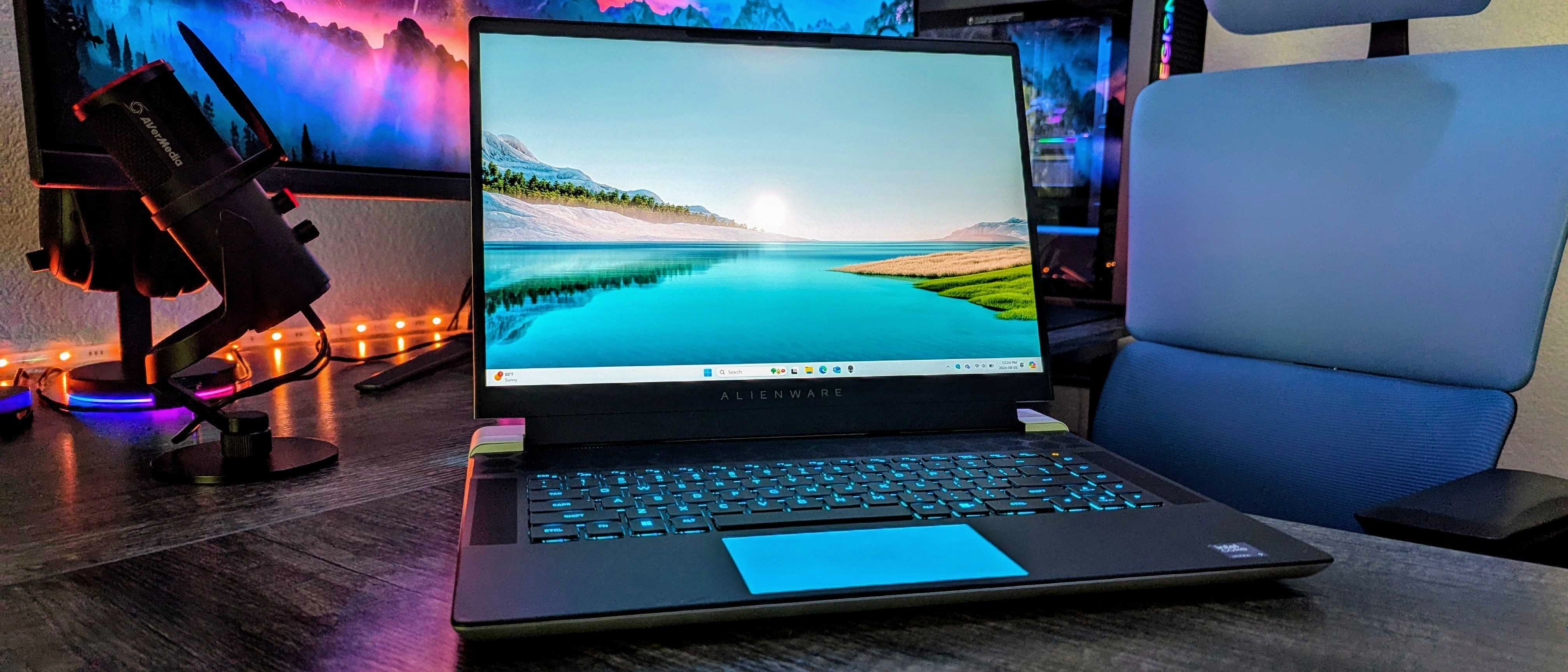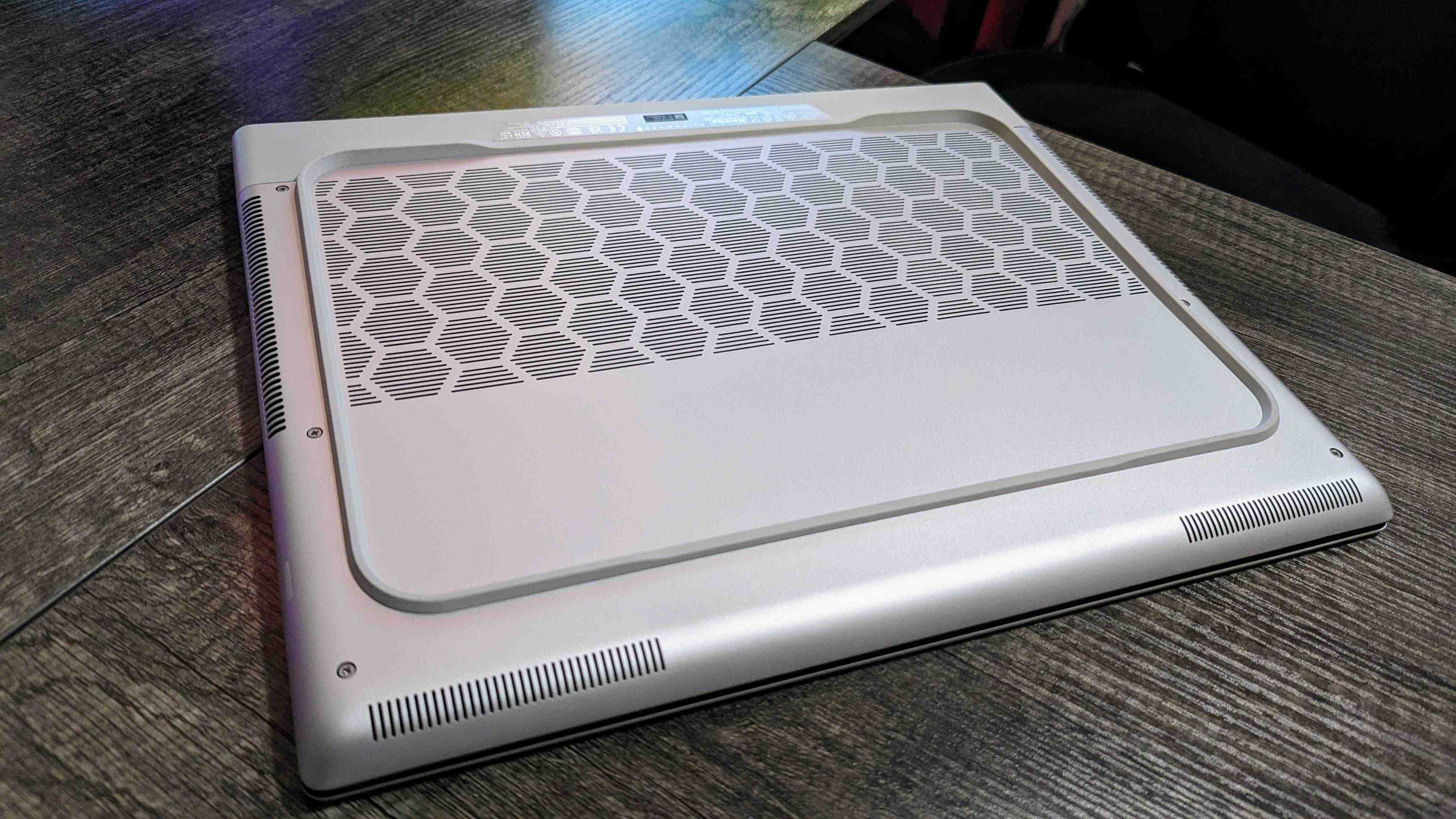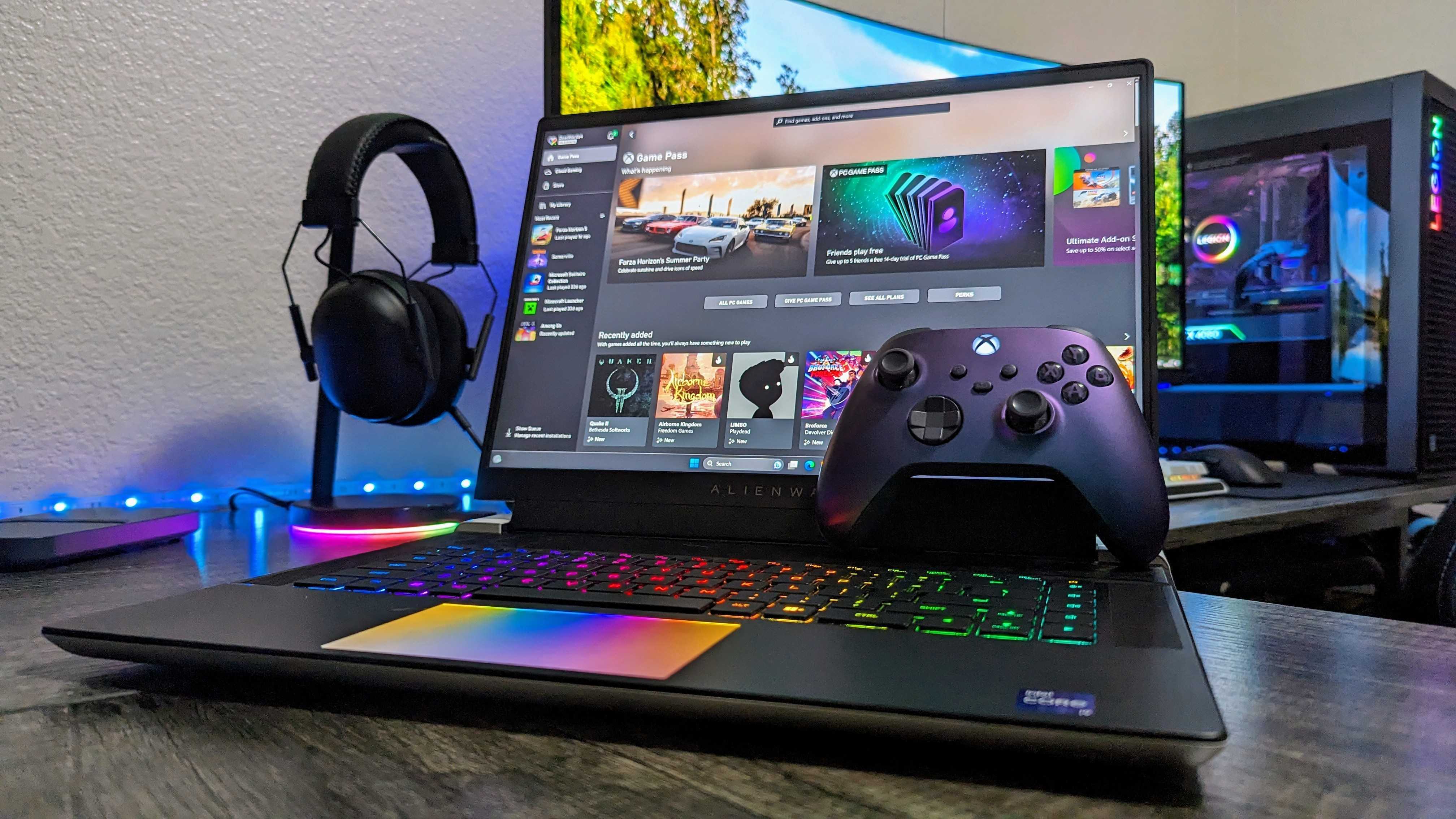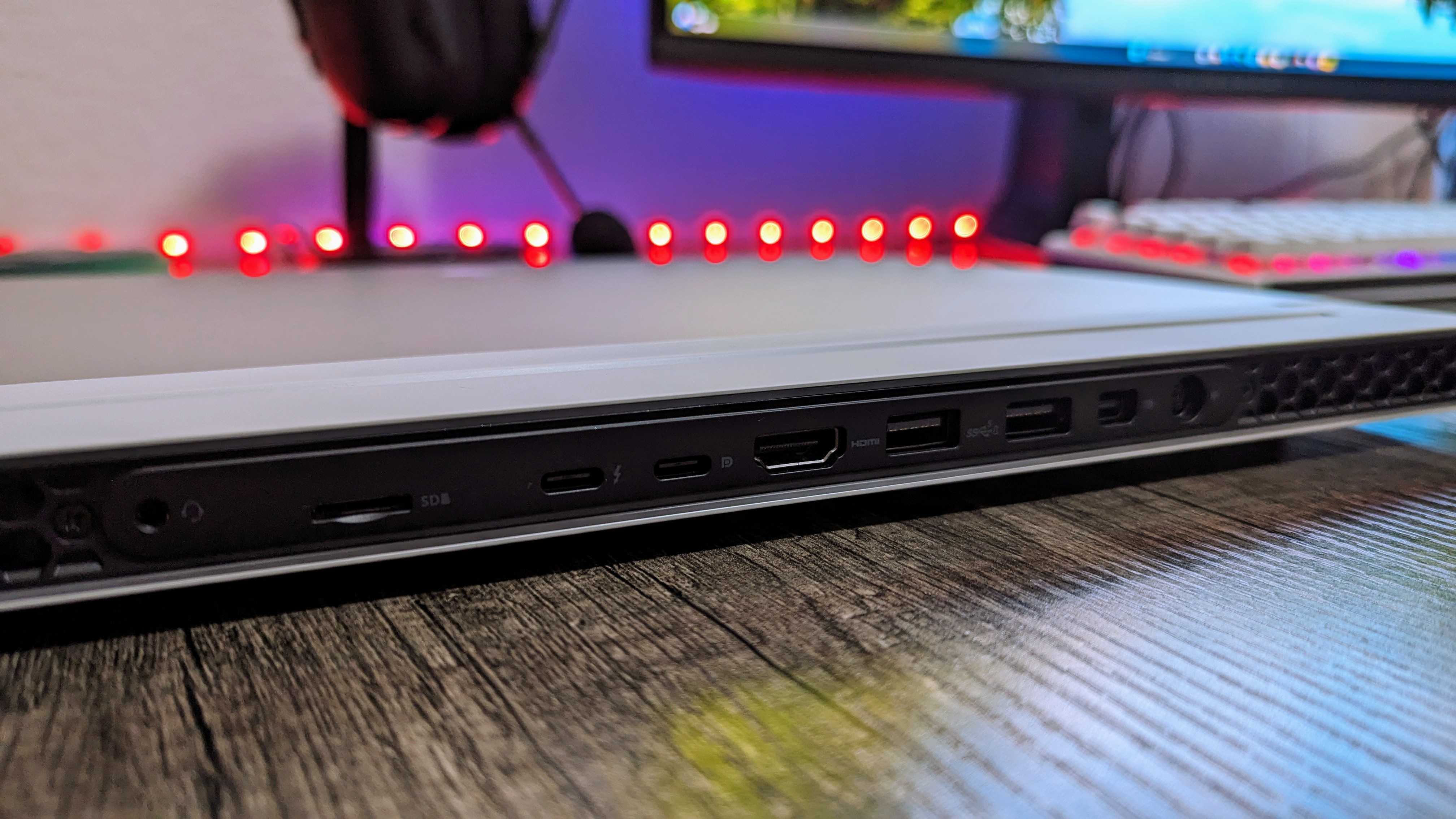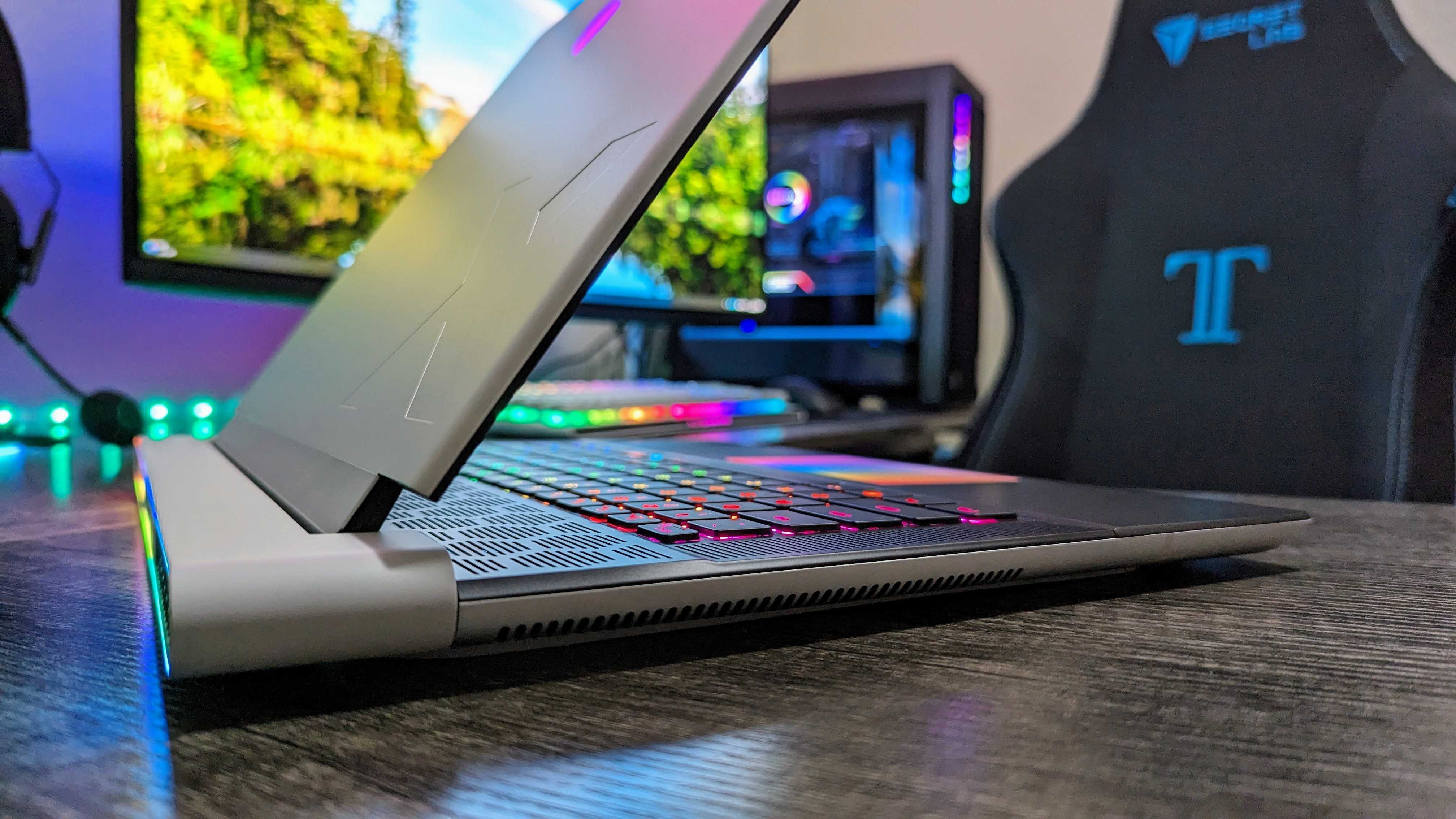Windows Central Verdict
The Alienware x16 R2 is nearly indistinguishable from its predecessor, with a switch from classic Intel Core to more efficient and AI-capable Core Ultra CPUs, improved thermal performance, and a handful of minor upgrades all being limited to the internals. It's still a good, premium gaming laptop with gorgeous hardware, but the marginally improved performance and lack of other notable updates makes the high price tag harder to swallow, even with it being a little more affordable than last year.
Pros
- +
It's still a beautiful, premium design with an amazing mechanical keyboard
- +
Thermal performance is considerably improved over last year
- +
Alienware's software has come a long way
- +
The pricing across the board has actually come down a bit
Cons
- -
Barely updated over last year's model
- -
Still very expensive, even while being cheaper than last year
- -
Still some minor issues and oddities
Why you can trust Windows Central
The Alienware x16 R2 is the second iteration of Dell's most premium, expensive gaming laptop. It's the flagship product from one of the oldest and most well-known players in the gaming hardware industry, so it comes with high expectations out of the box. Unfortunately, those expectations are leftovers from last year, as it's a challenge to an extreme degree to tell the difference between the R2 and the R1 that came before it.
I've been using the Alienware x16 R2, and it's true that Dell has improved this high-end laptop over its predecessor... But those differences are few and far between, and do little to justify the scorchingly high price tag. The switch to Intel Core Ultra and an upgraded cooling system mean you get much better thermal management without losing performance, and Alienware has refined its software over the last year, but does the x16 R2 have any surprises up its sleeves that make it a worthwhile choice over its top competitors — even some of Alienware's other gaming laptops?
This review was made possible thanks to a review sample provided by Dell. The company did not see the contents of the review before publishing.
Aug. 5, 2024 — Updated with our in-depth analysis and review of the Alienware x16 R2, the latest version of the Alienware x16 and an iterative update over the R1 from last year.
What's new with the Alienware x16 R2?
So, what is new with the Alienware x16 R2? Sadly, the list is a pretty short one overall, but what has changed is at least to this laptop's benefit. Well, some PC gamers may not agree with one specific change, but there is a method to Dell's madness... Even if that madness is extremely reserved this time around compared to Alienware's m-series gaming laptops.
Here are all the updates Dell made with the Alienware x16 R2:
- The 13th Gen Intel Core i7 and i9 CPU options of the Alienware x16 R1 are gone, replaced instead by the first-gen Intel Core Ultra 7 155H and Core Ultra 9 185H. These CPUs are designed to balance performance and efficiency, while also baking in a Neural Processing Unit (NPU) with 45 TOPS of power for AI computing. The end result is slightly less raw CPU power in exchange for (ideally) more features, longer battery life, and improved thermal performance.
- Speaking of cooling, Alienware has updated the "Cryo-Tech" thermal solution inside the x16 gaming laptop to reduce heat and improve sustained performance.
- The optional QHD+, 240Hz display of last year is now the default screen, with the previous entry-level 165Hz display falling off. There's still an FHD+, 480Hz option for those that prefer a higher refresh rate over a higher resolution.
- The FHD webcam with an IR sensor for Windows Hello now also supports High Dynamic Range (HDR), but is otherwise the same.
- Upgraded wireless connectivity brings Bluetooth 5.4 and Wi-Fi 7 support, versus the Bluetooth 5.3 and Wi-Fi 6E support of the R1.
- Finally, there's a new option to equip the Alienware x16 R2 with up to 8TB of SSD storage in a RAID 0 configuration (up from the 4TB ceiling of the R1).
- As an added bonus, the overall price of the Alienware x16 has fallen a little across the board.
That's essentially it. Physically, the Alienware x16 R2 is identical to its predecessor, with the exact same design, dimensions, ports, and hardware features. It's the same AlienFX RGB lighting, the same CherryMX mechanical keyboard, the same RGB-lit touchpad, the same six-speaker setup, the same 330W DC charging port, even the same NVIDIA RTX GPU options.
Side-by-side, the only way you could tell these two laptops apart is by the Intel sticker on the keyboard deck, and the user experience is largely the same, too. At least the changes are positive ones (and I do greatly appreciate Dell being very transparent about them).
Alienware x16 R2 review: Pricing and specifications
Pricing highlights
- The Alienware x16 R2 still starts at $1,799.99 at Dell, but that entry level configuration now includes a better GPU and display.
- In fact, the x16 is now a little more affordable across the board, thanks to a beefier entry-level model, better base display, and the switch to Intel Core Ultra.
- That being said, this laptop is still very expensive compared to the competition, and even to Alienware's own m-series laptops.
- Value rating: ⭐⭐⭐⭐
• Price: $3,099.99 at Dell
• Display: 16-inch, 16:10 aspect ratio, QHD+ (2,560 x 1,600) resolution, 240Hz refresh rate, 3ms response time, 300 nits max brightness, Dolby Vision HDR support, 100% DCI-P3 color gamut, NVIDIA G-Sync w/ Advanced Optimus, hardware MUX switch, non-touch
• CPU: Intel Core Ultra 9 185H (16 cores, up to 5.1GHz)
• GPU: NVIDIA GeForce RTX 4080 (12GB GDDR6 VRAM)
• NPU: Intel AI Boost (~11.5 TOPS)
• RAM: 32GB (2x 16GB, LPDDR5X @ 7,467MT/s)
• Storage: 1TB M.2 NVMe PCIe Gen 4.0 SSD
• Battery: 90Whr, 330W DC charger
• Dimensions: 364.8 x 290 x 18.6mm (14.36 x 11.41 x 0.73in)
• Weight: 2.72kg (6lbs)
Alienware is a well-established brand further bolstered by Dell's expertise, so it benefits from widespread availability, ample stock, fast shipping times, and plenty of configuration options. The Alienware x16 R2 starts from $1,799.99 at Dell, which is actually the same starting price as the x16 R1. However, the R2 actually comes with a faster FHD+, 480Hz display than the R1's now defunct QHD+, 165Hz display, and drops the base level NVIDIA GeForce RTX 4050 (which is frankly ridiculous to see in any premium gaming laptop) in favor of the more capable GeForce RTX 4060 GPU.
All the latest news, reviews, and guides for Windows and Xbox diehards.
We see this trend continue through all the Alienware x16 R2 configurations. Thanks to the move to Intel Core Ultra (and possible due to the same 40-series NVIDIA GPUs now being a year older), the x16 R2 is a little more affordable across the board. My review sample, for example, runs for $3,099.99 at Dell with a Core Ultra 9 CPU, RTX 4080 GPU, 32GB of RAM, 1TB of SSD storage, and a QHD+, 240Hz display. The equivalent x16 R1 from last year (with a Core i9 instead) ran for $3,250.
A fully specced out Alienware x16 R2 with Windows 11 Pro is $200 more than last year's equivalent model, but you're also getting twice the SSD storage, up to 8TB from 4TB. It's still a stretch to describe the Alienware x16 R2 "affordable," especially when compared to competitors from Lenovo or even other Alienware laptops, but it is good to see that prices came down a little overall. In the box, you get the Alienware x16 R2 and the (relatively) compact 330W GaN charging adapter.
Alienware x16 R2 (Core Ultra 9, RTX 4080, 32GB RAM, 1TB SSD) — $3,099.99 at Dell
The Alienware x16 R2 is actually the model I'd recommend, as this well-equipped and well-rounded configuration is also the most affordable that comes with the wonderful CherryMX mechanical keyboard. However, you can lose the keyboard and drop down to an RTX 4070 for a more reasonable $2,699.99 at Dell if you'd prefer.
Alienware x16 R2 review: Design and build quality
Design highlights
- The Alienware x16 R2 boasts the same design as last year, which isn't necessarily a bad thing.
- It's an attractive, premium gaming laptop made of high-quality materials and with lots of RGB lighting.
- Everything is basically identical, though, including the relatively limited port selection.
- Design rating: ⭐⭐⭐⭐
• Design features: Legend 3 design language & AlienFX RGB lighting w/ aluminum, magnesium alloy, stainless steel, and plastic
• Dimensions: 364.8 x 290 x 18.6mm (14.36 x 11.41 x 0.73in) • Weight: 2.72kg (6lbs)
• Ports: 1x USB Type-C Thunderbolt 4, 1x USB Type-C 3.2 Gen 2, 2x USB Type-A 3.2 Gen 1, 1x HDMI 2.1, 1x Mini DisplayPort 1.4, 1x microSD, 1x 3.5mm audio jack
One of the biggest differentiators between Alienware's x-series and m-series of gaming laptops is design. The x-series prioritizes premium materials, aesthetics, and fit and finish, while the m-series sacrifices that for thicker and more traditional chassis designs, often in exchange for improved performance or lowered costs. The Alienware x16 R2 still boasts the same "Legend 3" design language of its predecessor, in that it's essentially identical in every way.
This is still a stunning, undeniable premium gaming laptop, though, comfortably besting most other 16-inch alternatives at this price point. It is relatively thin (18.6mm), and looks quite slim thanks to subtle curves and thoughtful lines. Don't be mistaken, though, the Alienware x16 is still a beast of a laptop, coming in at 6lbs and with a longer footprint thanks to the rear-mounted ports and vents.
Most of the chassis is constructed from aluminum, with magnesium alloy and steel used for reinforcement. The keyboard deck, display bezels, and rear of the laptop are made of high-quality plastic; the deck, in particular, has a lovely soft-touch texture that feels great. The overall build quality continues to be exceptional with the R2, but (at least on my review unit) actually feels slightly worse than last year's R1. There's a little more flex in the keyboard deck and some noticeable gaps where the panels on the backend of the chassis meet, which weren't present on the R1.
Alienware's AlienFX is still in full display here, with the x16 R2 boasting per-key RGB lighting for every key (minus the spacebar) on the keyboard, a fully lit RGB touchpad, and a circular RGB ring around the entire rear of the laptop consisting of over 100 micro-LEDs. Every element of this RGB lighting can be customized in-depth via the Alienware Command Center, and it all looks great. You can even customize the colors of the power button for different power states! I just wish the spacebar enjoyed some lighting, too.
Finally, let's talk about ports. This is one area where I feel the Alienware x16 continues to fall short of other gaming laptops, and I believe Alienware's focus on aesthetics is to blame here. Every port is arrayed on the rear, split between the DC port, a couple USB Type-C ports, a couple USB Type-A ports, a couple display output ports, a microSD card slot, and an audio jack. There's no Ethernet here, and other gaming laptops will give you more USB ports to work with. Every port being on the rear instead of some USB ports also being on either side of the laptop feels a little inconvenient, too.
Overall, I still love the design of the Alienware x16, even if it's virtually unchanged versus last year. Other manufacturers are pushing the envelope in this department, though, making some aspects of the x16 R2 like its dated plastic display bezels and limiting port selection and placement stand out more.
Alienware x16 R2 review: Display quality
Display highlights
- The previous 16-inch, QHD+, 240Hz display of last year makes a return and is now the new default.
- It's pretty much identical, meaning it's a solid display with respectable performance that doesn't excel in any one category.
- The optional FHD+, 480Hz display is still here, too, but other companies have been pulling ahead of Alienware in the display department for a while, now.
- Display rating: ⭐⭐⭐½
• Display type: 16-inch IPS LCD w/ 16:10 aspect ratio
• Display options: QHD+ (2,560 x 1,600) @ 240Hz or FHD+(1,920 x 1,200) @ 480Hz
• Display features: 3ms response time, 300 nits max brightness, Dolby Vision HDR support, 100% DCI-P3 color gamut, ComfortView Plus blue light filter, NVIDIA G-SYNC & NVIDIA Advanced Optimus support, built-in MUX switch
When it comes to the display, virtually nothing has changed with the Alienware x16 R2. You still get a 16-inch panel with a 16:10 aspect ratio, a 3ms response time, NVIDIA G-SYNC and Dolby Vision support, 300 nits of brightness, Dell's ComfortView Plus blue light filtering technology, and both NVIDIA Advanced Optimus and a built-in MUX switch to ensure you're always using the GPU you need to get the best performance or efficiency. This time around, the entry-level QHD+, 165Hz panel is gone.
Now, the QHD+, 240Hz display that came on my x16 R1 review sample is the default screen, but you're still able to sidegrade to the FHD+, 480Hz display if you'd rather trade some sharpness for more smoothness. My Alienware x16 R2 model boasts the aforementioned QHD+ display with a 240Hz refresh rate, though, and my tests prove it's the same as last year.
| Setting | Brightness | Black | Contrast | White point |
|---|---|---|---|---|
| 0% | 19.3 | 0.01 | 1,410:1 | 5,700 (0.328, 0.329) |
| 25% | 66.6 | 0.06 | 1,210:1 | 5,700 (0.327, 0.329) |
| 50% | 112.3 | 0.10 | 1,170:1 | 5,800 (0.327, 0.329) |
| 75% | 207.4 | 0.18 | 1,160:1 | 5,800 (0.326, 0.329) |
| 100% | 357.8 | 0.32 | 1,130:1 | 5,900 (0.324, 0.329) |
As you can see, the QHD+, 240Hz display on the Alienware x16 R2 is still average, which is even more noticeable when other companies are pushing the boundaries with higher quality IPS LCD panels or OLED and miniLED displays. In contrast, the x16 R2 rocks the same panel from last year — contrast levels are a little lower and white balance is a little warmer, but it's all well within the margin of error. Nothing meaningful has improved here.
It's still the same middling max brightness that isn't nearly enough to actually make the Dolby Vision HDR support useful. The color accuracy is mostly the same, too, just barely missing the promised 100% of the cinematic DCI-P3 color gamut but otherwise testing alright. Contrast is also average for an IPS LCD display, as is the color reproduction and white balance. Everything is fine from a quality standpoint, but fine isn't enough when you're charging this much.
At the very least, performance is still exemplary. This display is smooth, responsive, and tear-free — it's perfect for competitive gaming, and I never had a single issue with it while playing some of the best PC games. If you want better HDR support or improved visual fidelity, though, you may have to hook up one of the best gaming monitors instead.
The Alienware x16 R2's display is even more disappointing than its predecessor because other high-end manufacturers like Razer are actively innovating with better display types like OLED and miniLED, better gaming performance, and superior image quality with more vibrant hues and higher brightness levels. The Lenovo Legion Pro 7i (Gen 9) uses an IPS LCD display, too, but it's brighter, boasts superior color accuracy and contrast levels, has an anti-glare coating to combat reflections, performs just as well, and it'll cost you less.
Alienware x16 R2 review: Performance and thermals
Performance highlights
- The Alienware x16 R2 is a very strong performer, as long as you don't compare it to its closest priced competitors.
- The move to Intel Core Ultra means the x16 R2 is actually slower than its predecessor in some tests, but faster in others.
- The difference is that thermal performance is significantly improved, helping the x16 R2 run cooler and at peak performance for longer than the x16 R1.
- Performance rating: ⭐⭐⭐⭐
• CPU: Up to Intel Core Ultra 9 185H (16 cores, up to 5.1GHz)
• GPU: Up to NVIDIA GeForce RTX 4090 (16GB GDDR6 VRAM)
• RAM: Up to 32GB LPDDR5X @ 7,467MT/s
• Storage: Up to 8TB NVMe PCIe SSD (w/ RAID 0)
• Thermals: Cryo-Tech design with quad-fans, Element 31 thermal paste, Perimeter Foot to aid air flow, broad vapor chamber on RTX 4080/4090 configurations
That the Alienware x16 R2 is a powerful gaming laptop, there is no doubt. This is supposed to be the pinnacle of the best Alienware gaming laptops, after all, and that means there is plenty of power under the hood. The more price conscientious can still obtain the premium design of the x16 R1 with more reasonable internals, but those willing to shell out the big bucks can expect fantastic gaming performance from this laptop... with some caveats.
In day-to-day use, the Alienware x16 R2 is a practically flawless performer. The laptop boots up quickly, apps open up instantly, and the laptop flies through my daily workflow with ease. That's the bare minimum for a laptop of this caliber, but it doesn't remain best-in-class for long. Still, Dell did make some important compromises with the R2 that overall make the laptop better than it was last year.






Let's just get the obvious out of the way: the Alienware x16 R2 is not more powerful than the x16 R1. While the Intel Core Ultra 9 inside this laptop is no slouch, it is slower on paper than the 13th Gen Core i9 inside this laptop's precursor, and it's certainly less powerful than the 14th Gen Intel CPUs we see in the most powerful gaming laptops I've tested. In actual usage this difference is largely negligible, but you do see the difference in the benchmarks above.
In PCMark 10, Geekbench 6, and CrossMark, the Alienware x16 R2 scored lower than the x16 R1 (which in turn scored lower than the actual most powerful Alienware laptop, the Alienware m18 R2). This laptop is no slouch, but it simply doesn't quite compare with the best in the same price range, like the phenomenally powerful (and well priced) Lenovo Legion Pro 7i (Gen 9). The x16 R2 is smooth and responsive, but it's not the smoothest or most responsive.
However, the trade-off for the switch to Intel Core Ultra may make the slightly lowered overall performance worth it (and no, I'm not talking about the AI capabilities).
Quad fans, a vapor cooling chamber, and more vents than you can count should translate to great thermal management, but the Alienware x16 R1 regularly toed the line for acceptable temperatures. When performing intense tasks or gaming, the x16 R1 quickly spun up the fans at max speed, became hot to the touch, and even began thermal throttling after short periods. It wasn't enough to make the laptop unusable and it never overheated or made games unplayable, but it was undeniably the laptop's biggest weakness.
The chassis is just as slim as last year, but the switch to Core Ultra CPUs and an improved thermal management system means the Alienware x16 R2 doesn't suffer from any of these issues. The fans are more hesitant to spin up, the laptop never got too hot to touch, and thermal throttling was well within the norm for a high-end, high-powered gaming laptop. It's a major improvement that means performance over long gaming sessions is actually better with the Alienware x16 R2 versus the R1, despite the latter's performance being higher in bursts.
This also means overclocking is a little more useful this time around, as the Alienware x16 R2 actually has some thermal headroom to squeeze even more performance out of these components. It'll never quite reach the heights of the best in the price category, but the x16 R2's improved thermals mean I would take it over the R1 any day of the week, even if the R1 does technically score higher in a lot of benchmarks.
The x16 R2 is a stronger performer than the R1 when off the charger, too. The NVIDIA GPU is still massively throttled, but the more efficient Intel Core Ultra with Intel Arc graphics handles battery power better than the Core i9 that came before it.
Alienware x16 R2 review: Gaming performance
Gaming highlights
- Overall gaming performance has improved over the last generation thanks to better thermal management.
- The Alienware x16 R2 has more than enough power to play all the latest and greatest PC games without issue.
- It's a very strong and consistent performer, but it's definitely not the most capable gaming laptop in its class.
The Alienware x16 R2 may not be the most powerful gaming laptop in the world, but it's still an incredible performer that tackles practically any PC game with ease. It mattered little what I threw at the x16 R2 because it handled it all at the highest settings. Gaming performance is actually slightly better this year despite having an (on paper) weaker CPU and the same GPU, and that's largely due to improved thermal management leading to considerably less throttling over time.
In 3DMark Time Spy, the Alienware x16 R2 performed exactly where you'd expect with its NVIDIA GeForce RTX 4080, besting any gaming laptop with an older or lower tier GPU. However, it does still fall on the lower end of the spectrum for gaming laptops equipped with an RTX 4080, even though the x16 R2 actually outperforms its predecessor when it comes to gaming.
Those superior thermals are definitely most noticeable when playing a graphically intense game, as the Alienware x16 R2 manages slightly higher framerates more consistently. Here are some of the games I tested on this laptop:
- Forza Horizon 5 — 119 FPS average with the Extreme preset, QHD+ (2,560 x 1,600) resolution, 240Hz refresh rate, v-sync enabled, NVIDIA DLSS Super Resolution and Frame Generation disabled / 168 FPS average with NVIDIA DLSS Super Resolution and Frame Generation enabled and set to "Auto," NVIDIA Reflex Low Latency enabled, NVIDIA DLAA disabled
- Gears 5 — 94 FPS average with the Recommended preset, QHD+ (2,560 x 1,600) resolution, uncapped framerate, v-sync enabled, Ultra textures installed
- Cyberpunk 2077 — 74 FPS average with the Ray Tracing: Ultra preset, QHD+ (2,560 x 1,600) resolution, 240Hz refresh rate, v-sync enabled, NVIDIA DLSS Super Resolution enabled and set to "Auto," NVIDIA DLSS Frame Generation and Ray Reconstruction disabled
- Counter-Strike 2 — 115-150 FPS average with the Very High preset, QHD+ (2,560 x 1,600) resolution, 240Hz refresh rate, v-sync enabled, NVIDIA Reflex Low Latency enabled, AMD FidelityFX Super Resolution disabled
Whatever game I tested, the Alienware x16 R2 handled it a little better than the x16 R1. The performance gains were minimal, but gameplay is more consistent and stable in general on the newer system with longer gaming sessions. In Forza Horizon 5, for example, the Alienware x16 R2 averaged 119 frames-per-second versus the 116 FPS average of the x16 R1. In Cyberpunk 2077 the gain was more subtle, with the x16 R2 playing at an average 74 FPS versus the R1 at 73 FPS.
Of course, I can't move on without mentioning how other laptops like the Lenovo Legion Pro 7i (Gen 9) still consistently outperform the Alienware x16 R2 in games. The Overdrive performance profile can gain you some extra frames by overclocking components like the GPU, though, with slightly higher and more reliable benefits this time around because the x16 R2 is better at keeping itself cool.
Alienware x16 R2 review: Battery experience
Battery highlights
- The Alienware x16 R2 is considerably better than the x16 R1 when it comes to endurance and performance while on battery power.
- That doesn't mean it's good, though — the x16 R2 just lasts longer on a charge when compared to other short-lived gaming laptops.
- The 330W charger is still relatively compact, fast, and more than capable of keeping the x16 R2 fully charged even during intense gaming sessions.
- Battery rating: ⭐⭐⭐½
I hope you're not expecting much from the Alienware x16 R2 battery life-wise because there's not much to say. Similar to other powerful gaming laptops, the x16 R2 absolutely chugs through its massive battery cell at a record pace. That being said, matters are actually considerably improved versus the x16 R1 from last year, as the newer laptop gets around 50% more endurance out of a fully charged battery on average.
It's still not great, but the improved battery life does move the Alienware x16 from the bottom tiers of gaming laptops to being slightly better than some of its biggest competitors.
In the PCMark 10 battery test, the Alienware x16 R2 clocked nearly three and a half hours before giving up the ghost. This was with mostly default settings, how most users will use this laptop. That means approximately 200 nits screen brightness, Balanced power mode, RGB lighting enabled, and the display refresh rate set to a dynamic 120Hz-240Hz. That's a little over an hour longer than the Alienware x16 R1, which ran this test at around 150 nits. Generating a Windows Battery Report returns similar results, too.
The SSD and other components aren't massively throttled when on battery power, which is good for performance. It means you can actually use the Alienware x16 R2 off the charger with little compromise when you need to. In fact, the Intel Core Ultra 9 and its Arc graphics make the x16 R2 a stronger performer on battery power than its predecessor, which is never a bad thing. When it's time to top up, the 330W GaN charger is compact (compared to other gaming laptop adapters) and is very fast.
Alienware x16 R2 review: Keyboard and touchpad
Keyboard highlights
- The CherryMX mechanical keyboard is excellent — great layout, travel, and tactile feedback
- The touchpad is definitely too small, but it is at least a solid touchpad (and it lights up).
- Customizable macro keys and separate media controls are nice to have.
- Other hardware rating: ⭐⭐⭐⭐½
With gaming laptops, the keyboard is almost as important as the internals that power the entire affair. With the Alienware x16 R2, Alienware spared no expense. This is a full-sized mechanical keyboard designed with CherryMX, the company behind the most popular keyboard switches in the world. the result is one of the best keyboards on any gaming laptop, period.
You get a cushy 1.8mm of travel, but you also get a wonderful, tactile click with every press. There's plenty of space between the keys, so you never feel cramped (the lack of a number pad also helps with this), the arrows are full-sized, as you'd expect for a gaming laptop (I'm looking at you, Razer), and Alienware baked-in standalone media controls, five programmable macro keys, and fantastic per-key RGB lighting.
This is one of the most responsive, comfortable keyboards I've had the pleasure of using. Within no time, I was absolutely flying on this keyboard, and it feels great to game on, too. I have zero complaints in this department. Bear in mind, however, that this mechanical keyboard does not come standard on the Alienware x16 R2, with base configurations including a more standard laptop keyboard. If you want this (and you should get it), you'll have to pay a little extra. Trust me, it's worth it.
The touchpad is less interesting. Most people will probably ignore the touchpad in favor of one of the best gaming mice, but it is there for when you need it. In those times, it serves its purpose. It uses Microsoft Precision drivers for gesture support and consistent performance, has a smooth glass surface, and reliable and tactile button actions. Yes, it's quite small, but I'd much rather keep the extra exhaust vents above the keyboard and the full-sized keyboard before accepting a bigger touchpad on a gaming laptop. Also, the entire touchpad has full RGB lighting. Nice.
Alienware x16 R2 review: Other hardware
Other hardware highlights
- Little about the Alienware x16 R2 hardware has changed, with the front-facing camera and microphone still being average.
- The six-speaker system is loud, has great low-ends, and sounds really good overall.
- Wireless connectivity has been upgraded, but I still miss the Ethernet port.
• Keyboard: CHERRY MX mechanical keyboard, 1.8mm of travel, 5x programmable macro keys, standalone media controls, full-sized arrow keys, per-key AlienFX RGB lighting, no number pad
• Touchpad: Microsoft Precision drivers, glass, AlienFX RGB lighting across entire surface
• Camera: FHD (1080p) @ 30fps front-facing camera w/ RGB & IR sensors for Windows Hello facial recognition, HDR support
• Audio: Dual-array microphones, six-speaker system (2x 2W tweeter, 4x 3W woofer) with Dolby Atmos
• Wireless: Wi-Fi 7, Bluetooth 5.4 with Intel Killer
The Alienware x16 R2 is equipped with a front-facing camera and microphone array for video conferences, streaming, and more, but it's understandably not the focus of this laptop. The quality of both camera and mics is average at best, with the camera lacking good color reproduction, low-light performance, and detail. You do get Windows Hello facial recognition, however, which makes signing in incredibly easy. This time around there's also HDR support, which is of limited use but is better to have than not.
Elsewhere, matters are far more positive. Alienware has included six speakers in the x16 R2, which should translate to fantastic audio. You get two tweeters on either side of the keyboard and then four woofers on either side of the keyboard and on the front-facing underside of the laptop. This means you get a frankly ridiculous volume level out of this speaker system — too loud to use at 100% when you're sitting right in front of the computer. For me, 40-50% was all I ever needed.
The sound quality is also good, with solid stereo separation and an appropriately wide soundstage tuned by Dolby Atmos. Low-end bass has a fair bit of punch, and you can actually feel the vibrations. Mids also sound really good, with great clarity. High-ends and voices are where the quality falls off a little, with voices in movies and video game cutscenes, in particular, sounding on the hollow and tinny side. Overall, though, this is a really solid speaker system and is more than good enough for regular use (including listening to music). Plus, it's loud enough to drown out the absurdly noisy fans.
Finally, the Alienware x16 R2 is on the cutting edge of wireless connectivity again. You get both Wi-Fi 7 and Bluetooth 5.4. Performance for both was rock solid, and I have absolutely no complaints. I was able to comfortably play competitive online games solely on Wi-Fi, and I never once experienced a drop or stutter with Bluetooth accessories like the Xbox Wireless Controller.
Alienware x16 R2 review: Software experience
Software highlights
- At the very least, a year of work has made the Alienware x16's software far more stable and reliable.
- I encountered significantly fewer issues with the R2, and the Alienware Command Center feels pretty good to use.
- Still, it's not perfect, as I ran into problems with the laptop freezing after closing a game or the fans spinning up when the laptop was asleep.
- Software rating: ⭐⭐⭐⭐
I am delighted to report that the Alienware x16 R2 has considerably better software than the R1 did when I reviewed it. Last year's Alienware x16 was plagued with a vast assortment of bugs and issues affecting the fans, the RGB lighting, Alienware Command Center, and much more. The R1's software dragged the laptop down a lot, but it has absolutely improved over time and the x16 R2 is the proof of that.
The suite of preinstalled apps and programs is still basically limited to the expected Dell, Alienware, Intel, NVIDIA, and hardware management programs, and it all actually worked out of the box. Alienware Command Center, especially, runs much better now than it did last year; it launches faster, feels smoother to navigate, and experiences fewer crashes, freezes, and slowdowns.
Last year, the x16 R1's RGB lighting frequently flickered, failed to turn on, or stayed turned on for far too long when the laptop was asleep. Those problems are also gone. It's a big step forward overall, but it's unfortunately not perfect. The Alienware x16 R2 still struggles with software more than the best gaming laptops I've reviewed, with two issues of note cropping up during my time testing this device.
First, the Alienware x16 R2 still freezes completely for two to three seconds after you close a game down, similar to its predecessor. I have no idea why this is, and it happens regardless of your performance settings. Second, the x16 R2 still has a tendency to randomly spin up its fans and become extremely hot (hotter than it ever does in actual usage) when it's closed and sleep. This issue is especially common when you use the laptop just for a few minutes and then close it again.
Still, I can't overlook how much grounded Dell has gained in the software department. Overall, the Alienware x16 R2 feels very good.
Alienware x16 R2 review: Competition
There's no shortage of gaming laptops, but there aren't too many as premium as the Alienware x16 R2. You definitely aren't without options, though, and there's one laptop I flat out recommend you check out instead of this one. The Lenovo Legion Pro 7i (Gen 9) is a phenomenal gaming laptop that perhaps isn't quite as attractive or slim as the x16 R2, but is considerably more powerful, boasts multiple hardware advantages, and is quite a bit cheaper across the board.
If you're fine spending even more on a laptop for the aesthetics and premium design, the Razer Blade 16 (2024) is a very good gaming laptop that more than competes with the Alienware x16 R2 on every hardware front... Except for the keyboard. The Blade 16 costs more than the Alienware x16, but Razer Blades boast some of the best hardware in the business in exchange.
- Recommended keyboard: Alienware Pro Wireless Gaming Keyboard for $199.99 at Best Buy
- Recommneded mouse: Alienware Pro Wireless Gaming Mouse for $149.99 at Best Buy
Of course, you can always look to Alienware's other laptops, too. The newly redesigned Alienware m16 R2 shares a ton with the x16 R2, except its a couple hundred dollars cheaper across every configuration. You're getting the same display and performance, but getting a more traditional design. If you need an absurd amount of power, you can also consider the Alienware m18 R2, which is a beast of a laptop that packs in the most powerful hardware available today.
Overall, though, the biggest competitor for the Alienware x16 R2 is absolutely the Lenovo Legion Pro 7i, and there's honestly not a ton of reasons to pay more for the x16 R2 unless you really do love the design, need the mechanical keyboard, or highly value Windows Hello facial recognition for logins.
Alienware x16 R2 review: Score card
| Attribute | Rating & notes |
|---|---|
| Value | 4/5 — Being a little more affordable across the board definitely helps the x16's case, but you can more power for less elsewhere. |
| Design | 4/5 — The Alienware x16 is still a gorgeous laptop, but a completely unchanged design and port selection makes it feel a little stale. |
| Display | 3.5/5 — The same display as last year also brings the same weaknesses, like brightness and image quality. |
| Performance | 4/5 — The x16 R2 isn't as powerful on paper as its predecessor, but better thermal management means it keeps up and them some. |
| Battery life | 3.5/5 — A 50% improvement in battery life still results in terrible battery life, but it has at least improved. |
| Other hardware | 4.5/5 — The mechanical keyboard, speakers, and wireless performance are all still excellent, making up for the average camera and touchpad. |
| Software | 4/5 — While not entirely devoid of issues, Alienware's software has progressed enough to be more than useable and even enjoyable. |
| Overall | 4/5 — The Alienware x16 R2 isn't my top pick for a premium gaming laptop, but overall I do believe the x16 R2 is better than what came before. |
Alienware x16 R2 review: Final thoughts
You should buy this if ...
✅You want a beautiful, premium gaming laptop with style
The Alienware x16 R2 has a style all its own, with a beautiful contrast between silver, white, and black. It's a gorgeous and slim laptop that is undeniably premium, and those who value design and want something flashier than the clean lines of a Razer Blade will love this.
✅You want a true mechanical gaming keyboard in a laptop
One of the highlights of the Alienware x16 R2 is undoubtedly its optional CherryMX mechanical keyboard, which puts the keyboards of other gaming laptops to shame. It's tactile, response, sounds wonderful, and has an excellent layout with additional macro and media keys.
✅You don't mind trading some power for efficiency
The Alienware x16 R2 absolutely is not the most powerful laptop in its class, with competitors from Lenovo and ASUS confidently outpacing it in benchmarks and performance metrics. Despite that, this laptop is still more than powerful enough to play all the latest and greatest PC games at max settings, and it does so while running cooler and with more power efficiency than the alternatives.
You should not buy this if ...
❌You want great bang for your buck
Alienware actually lowered the overall pricing with the x16 R2, making it a more attractive purchase across all configurations, but you can still find a lot more value looking elsewhere. You're paying extra for the style of the Alienware x16 R2 in a similar vein to Razer's Blade laptops; many desire exactly this, but others only care about the end user experience.
❌You need as much power as you can get
The Alienware x16 R2 may be priced alongside the most powerful gaming laptops in the world, but it doesn't quite count among them. It's a very impressive performer that certainly won't disappoint, but there are plenty of other laptops that beat it in sheer power and will return you higher framerates and shorter waits than the Alienware x16 R2, like the Lenovo Legion Pro 7i.
It's not accurate to claim I'm disappointed in the Alienware x16 R2, but I will admit that reviewing this laptop was boring. A paltry list of changes, some of which trade one con for another, means the x16 R2 barely feels any different than its predecessor. The end result is that Dell's pursuit of impeccable style continues to hamper the pursuit of ultimate performance — the Alienware x16 R2 is simply outclassed by more powerful laptops in the same price range.
Everything that impressed me about the Alienware x16 R1 is still here, though, and I will admit that the x16 R2 is the better laptop thanks to its vastly superior thermal management. The software is much smoother and more reliable this time around, too, although those specific improvements should've also applied to the x16 R1 by now, so that point is moot. At the end of the day, the Alienware x16 R2 is an incredibly well designed laptop with a ton of power and class, but it's not the gaming laptop I'd recommend many people buy.
In the same category, the Lenovo Legion Pro 7i (Gen 9) stands supreme, delivering much greater performance and a better all around experience than the Alienware x16 R2 — all while costing less. If you do spend the money on the Alienware x16 R2, you'll be getting an excellent gaming laptop from $1,799.99 at Dell... Just bear in mind that you might've been able to get a better laptop without spending more.
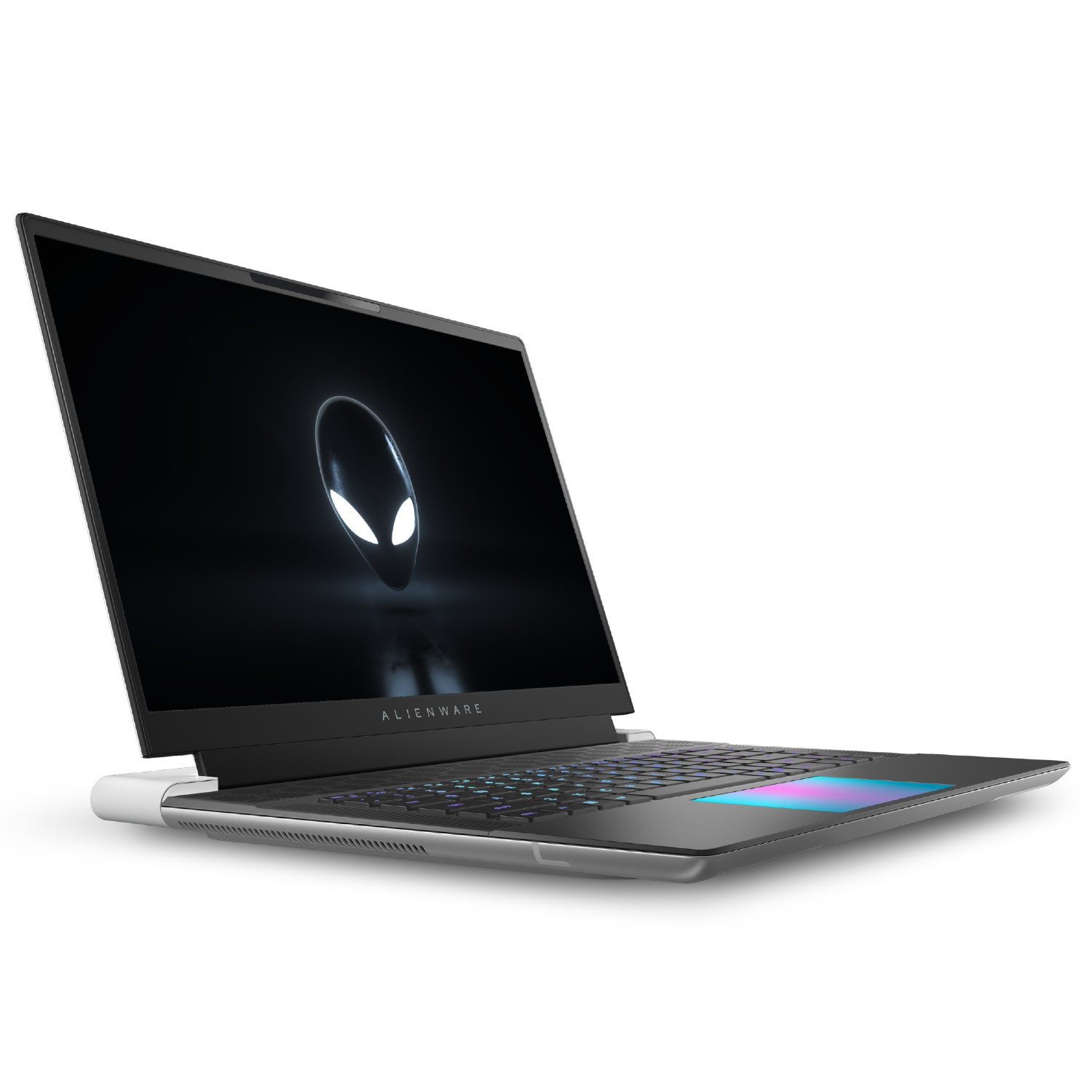
The Alienware x16 R2 is better than the laptop that came before it, but it still isn't quite as good as its competitors in the same price range. It remains an awesome gaming laptop with a truly incredible keyboard, though, so those who love its style really won't be disappointed if they pull the trigger.

Zachary Boddy (They / Them) is a Staff Writer for Windows Central, primarily focused on covering the latest news in tech and gaming, the best Xbox and PC games, and the most interesting Windows and Xbox hardware. They have been gaming and writing for most of their life starting with the original Xbox, and started out as a freelancer for Windows Central and its sister sites in 2019. Now a full-fledged Staff Writer, Zachary has expanded from only writing about all things Minecraft to covering practically everything on which Windows Central is an expert, especially when it comes to Microsoft.
